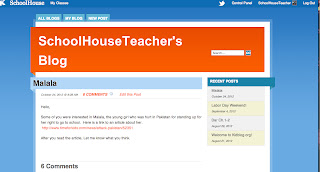When I looked ahead to see what kind of course activities were
coming up for November, I saw that we needed to attend a live webinar. I
immediately started scanning the suggested sites to see what courses I might
find interesting. I was interested in sharing
SCRATCH from MIT with my
students, but had not established how or when I was going to do that. When I
looked at the Discovery site, I saw that there was a live webinar hosted by Kyle
Schutt, called
“Game On! —A Webinar for Students”
The webinar was described in the following manner:
Games are a powerful way to engage students in the learning
process and develop a well-rounded set of literacy skills. In this webinar,
students will hear from 10th grade game designer Robert Nay, named one of the
top kid entrepreneurs to watch. Robert's Bubble Ball game ousted Angry Birds in
2011 as the top free game in the App Store. Join us as he shares his story and
his insights into the game design process. Additionally, learn how to use free tools
like Gamestar Mechanic, Game Salad, and Scratch to explore game design so you
can ultimately build and share original games. Teachers in attendance will be
exposed to a variety of resources including the Games as Learning Tools
resource guide provided for free on the Curiosity in the Classroom website.
Based on this description, I thought that this would be an
exiting and informational webinar that would appeal to my students. I read the description to my students and they
all agreed that they wanted to give it a try.
We signed in about 5 minutes early.
We used the chat section to introduce ourselves and greet the other participants. It was clear right away that there were
hundreds and hundreds of participants from around the country. The host had difficulty keeping up with all
of the questions and comments that were rapidly appearing in the chat column.
The webinar started on time and the young presenter, Robert
Nay, joined the broadcast. The host introduced Robert by showing a Today Show
video clip of Robert. The video clip described very thoroughly how Robert Nay
became a young game-maker.
The downside to the introduction was that Robert did not
seem to have much to add after this video was shown. He sort of retold what the video had
shown. Additionally the screen stayed
for a long time after the broad cast on just one image, so there was not any
new information to hear, and not much to look at.
After awhile, there were some questions from participants
regarding how to get past a particular level in Robert’s Bubble Ball game. Robert shared his screen and tried to
demonstrate a strategy, but unfortunately he was unable to solve his own game
with all of us watching. The host
brought everyone back to the topic and asked Robert a few questions. Robert was
not very talkative and did not elaborate much, so parts of the webinar were a
little awkward.
My students wrote questions down on sticky notes and I typed
them into the question area, but the host only responded to the posts in the
chat area. So, then I reposted the kids’
questions in the chat area, but there were so many people chatting, that our
questions disappeared in the lineup very quickly.
About 30 minutes into the webinar, when the host was just
beginning to start showing some of the game-making tools mentioned in the
description, my students began to check out.
Once they realized that they were not going to have their questions
answered they lost their focus. Once 1/3 of the class seemed to have lost
interest, I suggested that we sign out and explore SCRATCH on our own. The students were happy to move on to
something more interactive.
While my students can participate in webinars with me
monitoring their learning and their behavior, our program would not permit our
students to broadcast themselves live over any network.
I would use a live webinar again in the classroom. I think
that knowing you can sign out of the class if it is not meeting your needs
without disturbing other participants, is a plus. If I take my students on a fieldtrip, and we
are listening to a presentation that really is not engaging, or does not meet
our learning goals, it is much harder to leave gracefully. When I do try this again, I will make sure
that I have a related back up plan again.
It was very helpful to be able to move to another activity quickly and
smoothly.





